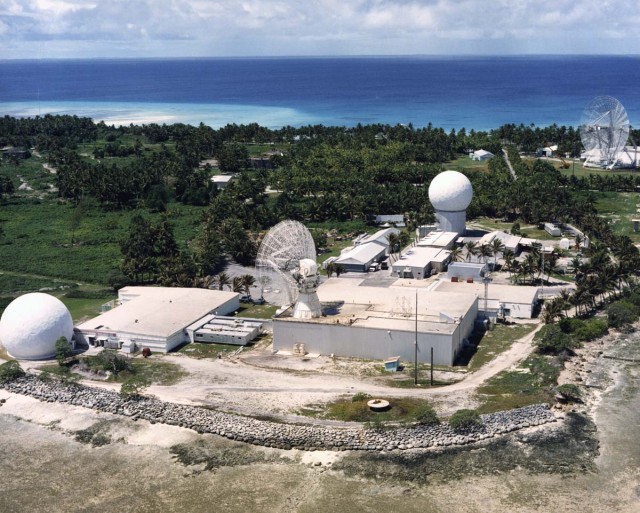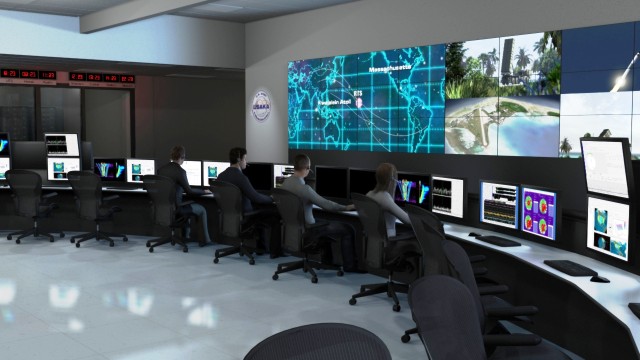HUNTSVILLE, Ala. - The Ronald Reagan Test Ballistic Missile Defense Test Site Operations Center (ROC) located in Huntsville helps save time and money while performing a vital mission for national defense from half a world away.
The ROC command and control facility at the U.S. Army Space and Missile Defense Command/Army Forces Strategic Command in Huntsville will soon become the primary command-and-control facility instead of its current location on Kwajalein Island. The communications upgrade focuses on the core networking and communications infrastructure linking Kwajalein to the United States and building a reliable, high bandwidth, low latency network is crucial to a distributed range in which the sensors are operated from more than 7,000 miles away.
"Here at the ROC, we are performing space and missile defense tracking and helping ensure the development of missile defense assets and systems, as well as helping verify that operational assets, whether offensive or defensive, are working correctly for the defense of both the nation and the Warfighters themselves," said. Lt. Col. Brian Soldon, U.S. Army Kwajalein Atoll and Reagan Test Site deputy commander (CONUS), Kwajalein support director and RTS space operation director.
The Ronald Reagan Ballistic Missile Defense Test Site is a world-class range and test facility located 2,300 miles southwest of Hawaii in the U.S. Army Kwajalein Atoll, Republic of the Marshall Islands. Its unique instrumentation sensors, including high-fidelity metric and signature radars, as well as optical sensors and telemetry, play a vital role in the research, development, test and evaluation in support of America's defense and space programs.
"The one great thing about this facility is that it is designed to eventually perform command and control of all sensors that support test operations and space operations out at the range," Soldon said.
The remote Pacific location is ideal for permissive safety and environmental constraints, but increases transportation cost and customer footprint requirements.
"We are trying to quantify the savings by being here as we go along," Soldon said. "The bottom line is this facility does allow us to pull a number of both contractors and some military and government employees off island to be able to execute operations from here.
"Our financial footprint is going down," he added. "It is resulting in a direct savings when it comes to not having to (permanent change of station) or place people on the island and it results in a lower percentage of the amount of housing required. It should result in around a 25 percent to 30 percent reduction in savings for the Army with respect to these types of traditional operating costs."
The RTS Distributed Operations (RDO) program will benefit Reagan Test Site customers in several key ways. RTS system engineers and mission planners will be available centrally in Huntsville, which is co-located with several major RTS customers. Customers will benefit from the range C2 being "closer" through reduced flight times and lesser time zone differences for training, demonstrations, mission planning and mission execution than experienced with Kwajalein-based RTS support.
A key advantage of a distributed center is a common environment which will allow better utilization of personnel by streamlining mission operations. Primary operations will be conducted from Huntsville while a backup mission capability is still retained at Kwajalein.
"We will still have to send people out to the island for certain missions, but the command and control for test and space operations, and the actual decision making piece can all be executed from this command center," Soldon said. "So when it comes to providing data required to meet specific key performance parameters (to our customers) they will be able to come to this location to actually execute."
With only two Soldiers and 23 civilians assigned to the ROC here in Huntsville and minimal contractor manpower resources, RTS customers will have the ability to view missions in real-time from the Huntsville control center, and only those mission support functions requiring physical access to RTS and test assets will need to deploy to Kwajalein.
"There will always be a requirement for someone to be out on the islands for operations due to safety requirements and safety is one of the biggest issues we take into consideration," Soldon said. "The ability to have the operations center here is going to make a big difference because now we are going to have closer interaction with the customers, as well as with the USASMDC/ARSTRAT command itself and it will be much easier to interact at the operational command decision making level.
"The ability to quickly make operational command decisions is a benefit," he added. "We will always have the requirement to have a significant presence, and a command presence, out on the range due to tactical safety concerns."
As the ROC mission continues to grow, one of the primary functions is to inform and support those organizations that monitor what takes place on the high ground.
"The U.S. Strategic Command mission that we support is primarily space situational awareness which includes metric observations of space objects so we know exactly where those objects are," Soldon said. "We also track new foreign launches and launches of interest that we want to ensure that we know what orbit they are going into and what payloads they have. We are able to operate the sensors at Reagan Test Site from here to track those launches and find out what orbit those launches are going into and provide that data to STRATCOM.
"From the sensors, we are also able to take wide-band images of space objects," he added. "We are able to use this space object identification imagery to be able to characterize what is being deployed from specific space launches, or to characterize space objects themselves."
He talked about how the average Soldier may not see how the ROC capabilities help them directly, but noted that the unseen benefits are immense and help them on several levels when they are deployed and in harm's way.
"A lot of people have a hard time identifying how space situational awareness affects the Soldiers on the ground," Soldon said. "What it boils down to, is that satellites up in space are executing critical support requirements for the Warfighter. Whether that is navigational support, in terms of (global positioning satellites) or whether it is communication satellites in low-earth orbit and those in higher orbits, there are also a number of intelligence, surveillance and reconnaissance assets that are up there and we need to know exactly where those are at all times.
"One; so we can know exactly where they are, but also to ensure they don't collide with any other objects. RTS is one of the sensors that provide that capability," he added. "We are one of the critical space surveillance sensors that ensure nothing collides so that assets continue to do their support functions for our Warfighters on the ground."




Social Sharing